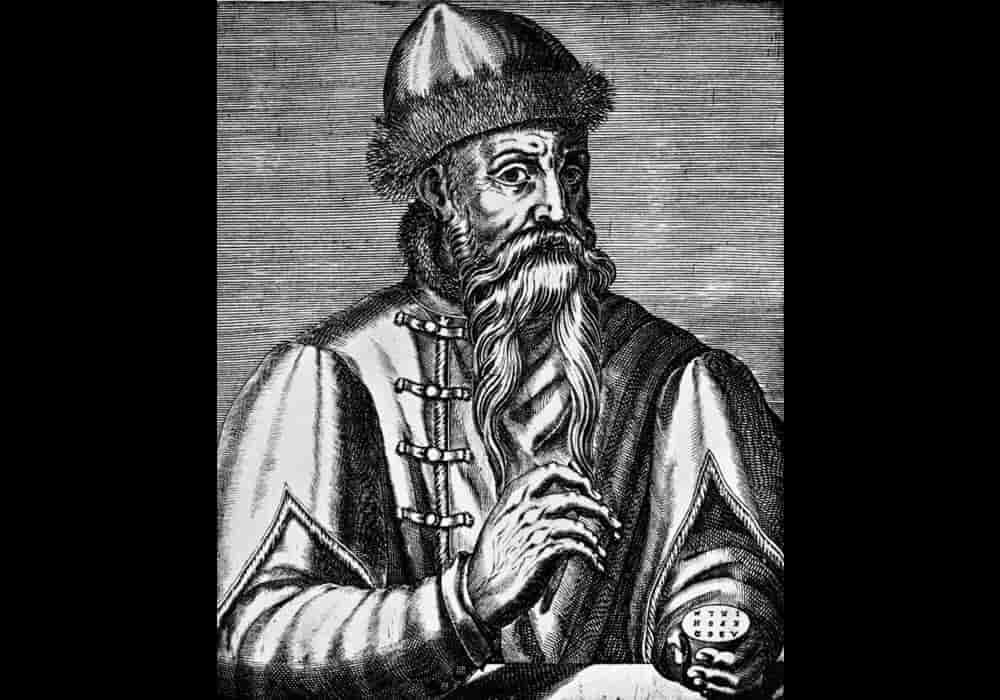Johannes Gutenberg
Of German origin, Johannes Gutenberg changed the face of history in the 15th century thanks to his invention, considered a major event of the Renaissance. In 1450, he persuaded Johann Fust, a wealthy banker, to invest in his project and to become his partner. The two men decide to print the first book in history. At the time, it was the Bible that could be this first printed work, for what normally required more than three years of work on the part of the copyist monks.
Between 1452 and 1455, the Bible was printed in 180 copies. However, success is not at the rendezvous and Johann Fust takes Johannes Gutenberg to court by demanding the restitution of the sums he paid him. Johannes Gutenberg loses the case and must thus give up his printing equipment to the banker. Two years later, Johann Fust joined forces with Peter Schöffer, worker of Johannes Gutenberg. Together they print the Psalmorum Codex.
The German printer does not let down and continues to work on his invention. In 1459 he participated in a new edition of the Bible and a year later in the printing of the Catholicon dictionary. Living modestly, he was ennobled in 1465 by the Archbishop of Mainz, Adolphe II of Nassau. Having become a gentleman, Johannes Gutenberg benefits from a pension and various advantages. He died in 1468, unknown to his contemporaries and buried in Mainz in a cemetery now destroyed.
Read also: Most Famous Paintings in the World
The invention of printing
Gutenberg’s most important idea was sparked when he worked as a goldsmith in Mainz. He got the idea to produce indulgence letters by forming letterhead to print indulgence letters in large numbers so that he could get lots of money to pay his debts when he worked as a metalworker first. Gutenberg perfected small metal type. At that time, books and letters were written in Latin script by hand and contained many errors during copying, besides that, the disadvantage was that they were slow.
Therefore, Gutenberg made the first reference to metal letters by using lead to form Latin script. At first, Gutenberg was forced to create nearly 300 letterforms to imitate the cursive handwritten form. After that, Gutenberg made them a moving press for printing. This mobile printing press is Gutenberg’s biggest contribution. After perfecting his mobile printing press, Gutenberg printed thousands of indulgences that were abused by the Catholic Church. This abuse is the culmination of opposition from some parties such as Martin Luther.
Bible Printing by Johannes Gutenberg
In 1452, Gutenberg secured a loan from Johann Fust to start a famous Bible printing project. However, Gutenberg had been fired from the Bible printing arrangement before it was fully prepared because Gutenberg was accused of printing indulgences, calendars and light reading books as free time. However the resulting Bible is still known as the Gutenberg Bible which contains 42 lines per page prepared which was on August 15, 1456 and is considered to be the oldest printed book in the western world.
Two hundred copies of the Gutenberg Bible have been printed, small portions (about 50) printed on calf hides. The beautiful and expensive Gutenberg Bible sold for three years’ salary for an ordinary coolie. It was sold at the Frankfurt Book Fair in 1456. Roughly speaking, nearly a quarter of Gutenberg’s Bibles are still preserved today.
The trial and the ruin
Unfortunately for Gutenberg, the printing of books has met with mixed success. In the inventory of his workshop, the Bibles will remain on the shelves for some time.
Fust, who has invested more than 2,500 guilders in the business, is furious with Gutenberg because he had promised him quick success. Gutenberg refusing to pay – or not being able to – the interest and the capital which he had lent him, he decides to take the matter to justice. The court ruled in favor of Fust, recognizing, however, that it was not a loan but an investment, and that Fust was not a lender but a partner.
Fust then obtains the management of the workshop and the pledge of the press. He continues the printing business under his own name. In the oldest edition of the Psalmorum Codex, which first appeared on August 14, 1457, only the names of Fust and Schoeffer are mentioned. This book, remarkable for its print quality, for its text printed in black and red and for the regularity of the font, decorated with ornate and watermarked drop caps, brought a certain notoriety to the two men.
To expand their clientele and go beyond the small circle of cultivated bourgeois and academics, Fust and Schoeffer quickly orient their production towards smaller editions, but easier to sell. They moved to Paris to sell their books there in 1463, a date when printing did not yet exist in France. Fust did not profit from this for long: he died in Paris in 1466, but he still had time to see a number of printers of Germanic origin set up in the rue Saint-Jacques.
Gentleman Gutenberg
Insolvent, Gutenberg tries to revive a printing workshop and in 1459 participates in an edition of the Bible in the city of Bamberg. Since his work bears no date or name, it is still difficult to identify with certainty the documents from his workshop. The Catholicon dictionary of seven hundred and forty-four pages, printed in three hundred copies in Mainz in 1460, is of his composition. Among other things, he prints letters of indulgence. From 1461, we no longer find any traces of publication from Gutenberg’s Mainz workshop. No doubt he is too old to exercise his activity, but it is possible that he taught his art for a fee.
In January 1465, while living modestly in the Algesheimer Hof (de) hospice, Gutenberg was appointed a gentleman to the Archbishop of Mainz Adolphe II of Nassau. He then receives an annuity and various benefits in kind. He probably died on February 3, 1468, largely unknown to his contemporaries, and was buried in Mainz in a cemetery which was later destroyed. His grave is now lost.
Sources: Pinterpandai, Biography
Photo credit: Wikimedia Commons
Photo explainations: Johannes Gutenberg (139*-1468); Kupferstich; 16th century; 19:14 cm.



